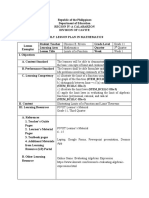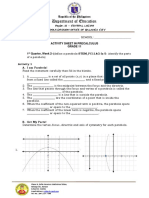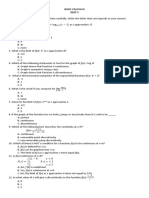100%(1)100% found this document useful (1 vote)
219 viewsLimits of Trig Functions
This document provides an introduction to limits of trigonometric functions. It defines what a limit is, gives an overview of trig functions, and discusses how to evaluate one-sided limits, limits at infinity, and limits algebraically. Real-world applications to sound waves and tides are also covered.
Uploaded by
Dan MonevaCopyright
© © All Rights Reserved
Available Formats
Download as PPTX, PDF, TXT or read online on Scribd
100%(1)100% found this document useful (1 vote)
219 viewsLimits of Trig Functions
This document provides an introduction to limits of trigonometric functions. It defines what a limit is, gives an overview of trig functions, and discusses how to evaluate one-sided limits, limits at infinity, and limits algebraically. Real-world applications to sound waves and tides are also covered.
Uploaded by
Dan MonevaCopyright
© © All Rights Reserved
Available Formats
Download as PPTX, PDF, TXT or read online on Scribd
You are on page 1/ 21
Welcome to Limits of Trigonometric Functions
Welcome to Limits of Trigonometric Functions
Welcome to Limits of Trigonometric Functions
● Today we'll explore how trigonometric functions behave as they
approach specific values.
● We'll learn to evaluate these limits and apply them to real-world
scenarios.
● Are you ready to see how calculus helps us understand the
motion and cycles around us?
What is a Limit?
● A limit describes the value a function approaches as the input gets closer to a
certain number.
● It's like watching a car approach a stop sign—it gets closer and closer but
doesn't go beyond the sign.
● Why do you think understanding limits is important in mathematics?
Trigonometric Functions Overview
● Recall the main trigonometric functions: sine (sin), cosine (cos), and tangent
(tan).
● These functions relate angles to ratios of sides in right triangles.
● They also model periodic phenomena like sound waves and tides.
● How can you see these functions in action in everyday life?
Graphing Trigonometric Functions
● A graph can show us how trig functions behave over a range of
values.
● Notice the repeating patterns? These are called cycles or
periods.
● Can you identify the amplitude and period of the function on the
graph?
Understanding Limits with
Sine Function
● Let's look at the limit of sin(x) as x
approaches a specific value.
● The sine function oscillates between -1
and 1.
● What do you think happens to sin(x) as x
approaches infinity?
Calculating Limits Algebraically
● We can find limits by substituting the value that x is approaching into the
function.
● Sometimes, we need to simplify the expression first using trigonometric
identities.
● Try calculating the limit of sin(x)/x as x approaches 0. What's your strategy?
One-Sided Limits
● Limits can be from the left (approaching the value from smaller
numbers) or from the right (from larger numbers).
● These are called one-sided limits and are written as lim(x→c-) or
lim(x→c+).
● Why might it be important to consider the direction from which we
approach a value?
Limits at Infinity
● Some limits involve x approaching infinity or negative infinity.
● For trigonometric functions, this often means looking at the behavior over
many cycles.
● What patterns do you notice in trig functions as x goes to infinity?
Continuity and Limits
● A function is continuous if there are no breaks, jumps, or holes in its graph.
● For a function to be continuous at a point, the limit as x approaches that point
must equal the function's value there.
● Can you think of a trigonometric function that is always continuous?
Practice Problem #1
● Evaluate the limit of sin(x) as x approaches π/2.
● Hint: Consider the value of sin(π/2) and how sin(x) behaves near
π/2.
● Share your approach with a classmate. Did you both get the
same result?
Practice Problem #2
● Find the limit of tan(x) as x approaches 0.
● Remember that tan(x) = sin(x)/cos(x). How does this identity help us?
● Discuss with a partner why tan(x) behaves the way it does near 0.
Trigonometric Identities and Limits
● Trigonometric identities can simplify complex limit problems.
● Identities like Pythagorean, angle sum, and double angle are especially
useful.
● How might you use the identity sin^2(x) + cos^2(x) = 1 to find a limit?
Real-World Application: Sound Waves
● Sound waves can be modeled using sine and cosine functions.
● The limit concept helps us understand the behavior of these
waves under different conditions.
● Imagine a sound getting quieter. How might limits describe this
change?
Real-World Application: Tides
● Tidal patterns are another example of periodic behavior modeled by trig
functions.
● Limits help predict the height of tides at different times.
● How could knowing the limits of tide heights be useful for a coastal city?
Exit Ticket Question
● Before you leave, answer this: What is the limit of cos(x) as x approaches 0?
● Think about the value of cos(0) and how cos(x) behaves near 0.
● Submit your answer before you exit the classroom.
Lesson Recap
● Today we covered the definition of limits and how to evaluate
them for trig functions.
● We also discussed one-sided limits, limits at infinity, and
continuity.
● What was the most interesting thing you learned about limits
today?
Next Steps in Calculus
● Next lesson, we'll dive into derivatives and their connection to limits.
● Think about how the slope of a tangent line might relate to the limits we've
discussed.
● Are there any questions you have about today's material that you'd like to
explore further?
Homework Assignment
● Practice evaluating limits with the worksheet provided.
● Use graphing calculators to check your work.
● Be prepared to discuss your solutions and any challenges you faced next
class.
Thank You and Keep Practicing!
● Great work today exploring the limits of trigonometric functions!
● Remember, practice is key to mastering calculus concepts.
● Keep questioning, keep calculating, and see you next class!
You might also like
- Third Quarter Examination in Basic Calculus100% (1)Third Quarter Examination in Basic Calculus4 pages
- (Stem - Bc11Lc-Iiia-1) (Stem - Bc11Lc-Iiia-2) (Stem - Bc11Lc-Iiia-3) (Stem - Bc11Lc-Iiia-4)No ratings yet(Stem - Bc11Lc-Iiia-1) (Stem - Bc11Lc-Iiia-2) (Stem - Bc11Lc-Iiia-3) (Stem - Bc11Lc-Iiia-4)6 pages
- Department of Education: Republic of The PhilippinesNo ratings yetDepartment of Education: Republic of The Philippines8 pages
- Limits of Exponential, Logarithmic and Trigonometric FunctionsNo ratings yetLimits of Exponential, Logarithmic and Trigonometric Functions5 pages
- The Derivative As The Slope of The Tangent Line: (At A Point)No ratings yetThe Derivative As The Slope of The Tangent Line: (At A Point)20 pages
- Lesson 5 Continuity of Piecewise FunctionNo ratings yetLesson 5 Continuity of Piecewise Function33 pages
- Topic 1.6-Limits of Some Transcendental FunctionsNo ratings yetTopic 1.6-Limits of Some Transcendental Functions17 pages
- 11 Basic Calculus 1st: Session 1 Session 2 Session 3 Session 4No ratings yet11 Basic Calculus 1st: Session 1 Session 2 Session 3 Session 46 pages
- Basic Calculus: Learning Activity Sheet Limits Background Information For LearnersNo ratings yetBasic Calculus: Learning Activity Sheet Limits Background Information For Learners15 pages
- Lesson 2 The Differentiation Rules For Algebraic FunctionsNo ratings yetLesson 2 The Differentiation Rules For Algebraic Functions27 pages
- Basic Calculus-Quarter 3: Asseeement # 1No ratings yetBasic Calculus-Quarter 3: Asseeement # 16 pages
- Topic 1.3-1.4 Limit Theorems and Limits of Algebraic FunctionsNo ratings yetTopic 1.3-1.4 Limit Theorems and Limits of Algebraic Functions13 pages
- I. IDENTIFICATION (2 Points Each) : F (X) and F (C) IfNo ratings yetI. IDENTIFICATION (2 Points Each) : F (X) and F (C) If2 pages
- Week2 L4 5 Limits of Transcendental FunctionsNo ratings yetWeek2 L4 5 Limits of Transcendental Functions30 pages
- GenMath Q1 W9 Logarithmic-Functions-and-their-Graphs Elegado Bgo100% (1)GenMath Q1 W9 Logarithmic-Functions-and-their-Graphs Elegado Bgo29 pages
- Basic Calculus: Group Performance Task #1No ratings yetBasic Calculus: Group Performance Task #135 pages
- Precalculus Budget of Works 1st Sem Sy 2023 2024No ratings yetPrecalculus Budget of Works 1st Sem Sy 2023 20242 pages
- LMS Week 5 CALC 1034 Differentiation RulesNo ratings yetLMS Week 5 CALC 1034 Differentiation Rules73 pages
- Basic-Calculus - Continuity-Of-A-FunctionNo ratings yetBasic-Calculus - Continuity-Of-A-Function21 pages
- Basic Calculus q3 w6 Lesson 61 Determine The Relationship Between Diffentiability and Continuity of A FunctionNo ratings yetBasic Calculus q3 w6 Lesson 61 Determine The Relationship Between Diffentiability and Continuity of A Function5 pages
- Daily Lesson Log of Stem - Bc11Lc-Iiib-2: 1. Explain How The Answer Was Arrived at 2. 3. 4No ratings yetDaily Lesson Log of Stem - Bc11Lc-Iiib-2: 1. Explain How The Answer Was Arrived at 2. 3. 42 pages
- Basic Calculus: Engr. Oscar H. Halamani, JRNo ratings yetBasic Calculus: Engr. Oscar H. Halamani, JR12 pages
- Grade 11 Midterm Exam General MathematicsNo ratings yetGrade 11 Midterm Exam General Mathematics5 pages
- Distinguishing Between Parameter and StatisticNo ratings yetDistinguishing Between Parameter and Statistic11 pages
- The Higher Order Derivatives of FunctionsNo ratings yetThe Higher Order Derivatives of Functions15 pages
- Complex Variables and Numerical Methods - BTech Mechanical Engineering Notes, Ebook PDFNo ratings yetComplex Variables and Numerical Methods - BTech Mechanical Engineering Notes, Ebook PDF92 pages
- David J. Griffiths - Introduction To Electrodynamics - Instructor's Solutions Manual (1999)No ratings yetDavid J. Griffiths - Introduction To Electrodynamics - Instructor's Solutions Manual (1999)250 pages
- Get Introduction to Modern Analysis, 2nd Edition Kantorovitz free all chaptersNo ratings yetGet Introduction to Modern Analysis, 2nd Edition Kantorovitz free all chapters41 pages
- Applied Mathematics Iii: Rhodes University Department of Mathematics (Pure & Applied) Examination: June 2009No ratings yetApplied Mathematics Iii: Rhodes University Department of Mathematics (Pure & Applied) Examination: June 20094 pages
- NCERT Solutions For Class 12 Maths Chapter 3 Matrices Miscellaneous ExerciseNo ratings yetNCERT Solutions For Class 12 Maths Chapter 3 Matrices Miscellaneous Exercise13 pages
- 11.1 - Eigenvalue Problems for y'' + λy = 0 - Mathematics LibreTextsNo ratings yet11.1 - Eigenvalue Problems for y'' + λy = 0 - Mathematics LibreTexts5 pages
- Cazenave & Haraux - An Introduction To Semilinear EvolutionNo ratings yetCazenave & Haraux - An Introduction To Semilinear Evolution198 pages
- (Stem - Bc11Lc-Iiia-1) (Stem - Bc11Lc-Iiia-2) (Stem - Bc11Lc-Iiia-3) (Stem - Bc11Lc-Iiia-4)(Stem - Bc11Lc-Iiia-1) (Stem - Bc11Lc-Iiia-2) (Stem - Bc11Lc-Iiia-3) (Stem - Bc11Lc-Iiia-4)
- Department of Education: Republic of The PhilippinesDepartment of Education: Republic of The Philippines
- Limits of Exponential, Logarithmic and Trigonometric FunctionsLimits of Exponential, Logarithmic and Trigonometric Functions
- The Derivative As The Slope of The Tangent Line: (At A Point)The Derivative As The Slope of The Tangent Line: (At A Point)
- 11 Basic Calculus 1st: Session 1 Session 2 Session 3 Session 411 Basic Calculus 1st: Session 1 Session 2 Session 3 Session 4
- Basic Calculus: Learning Activity Sheet Limits Background Information For LearnersBasic Calculus: Learning Activity Sheet Limits Background Information For Learners
- Lesson 2 The Differentiation Rules For Algebraic FunctionsLesson 2 The Differentiation Rules For Algebraic Functions
- Topic 1.3-1.4 Limit Theorems and Limits of Algebraic FunctionsTopic 1.3-1.4 Limit Theorems and Limits of Algebraic Functions
- I. IDENTIFICATION (2 Points Each) : F (X) and F (C) IfI. IDENTIFICATION (2 Points Each) : F (X) and F (C) If
- GenMath Q1 W9 Logarithmic-Functions-and-their-Graphs Elegado BgoGenMath Q1 W9 Logarithmic-Functions-and-their-Graphs Elegado Bgo
- Basic Calculus q3 w6 Lesson 61 Determine The Relationship Between Diffentiability and Continuity of A FunctionBasic Calculus q3 w6 Lesson 61 Determine The Relationship Between Diffentiability and Continuity of A Function
- Daily Lesson Log of Stem - Bc11Lc-Iiib-2: 1. Explain How The Answer Was Arrived at 2. 3. 4Daily Lesson Log of Stem - Bc11Lc-Iiib-2: 1. Explain How The Answer Was Arrived at 2. 3. 4
- Complex Variables and Numerical Methods - BTech Mechanical Engineering Notes, Ebook PDFComplex Variables and Numerical Methods - BTech Mechanical Engineering Notes, Ebook PDF
- David J. Griffiths - Introduction To Electrodynamics - Instructor's Solutions Manual (1999)David J. Griffiths - Introduction To Electrodynamics - Instructor's Solutions Manual (1999)
- Get Introduction to Modern Analysis, 2nd Edition Kantorovitz free all chaptersGet Introduction to Modern Analysis, 2nd Edition Kantorovitz free all chapters
- Applied Mathematics Iii: Rhodes University Department of Mathematics (Pure & Applied) Examination: June 2009Applied Mathematics Iii: Rhodes University Department of Mathematics (Pure & Applied) Examination: June 2009
- NCERT Solutions For Class 12 Maths Chapter 3 Matrices Miscellaneous ExerciseNCERT Solutions For Class 12 Maths Chapter 3 Matrices Miscellaneous Exercise
- 11.1 - Eigenvalue Problems for y'' + λy = 0 - Mathematics LibreTexts11.1 - Eigenvalue Problems for y'' + λy = 0 - Mathematics LibreTexts
- Cazenave & Haraux - An Introduction To Semilinear EvolutionCazenave & Haraux - An Introduction To Semilinear Evolution
































































































